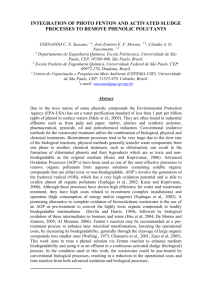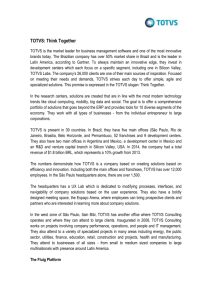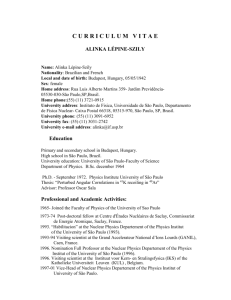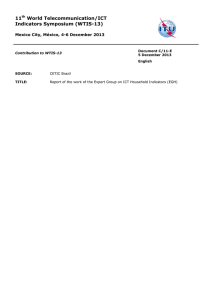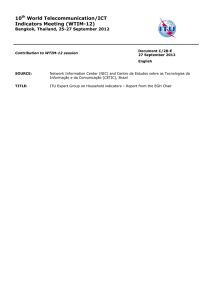Child Online Protection: The Brazilian Experience in producing statistical indicators
advertisement
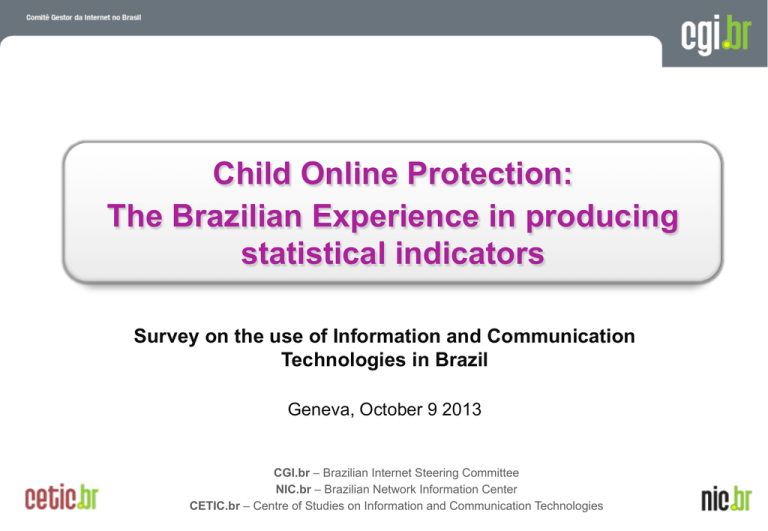
Child Online Protection: The Brazilian Experience in producing statistical indicators Survey on the use of Information and Communication Technologies in Brazil Geneva, October 9 2013 CGI.br – Brazilian Internet Steering Committee NIC.br – Brazilian Network Information Center A evolução da Internet no Brasil CETIC.br – Centre of Studies on Information and Communication Technologies 26 de março de 2009 – São Paulo Brazil Context: Facts and figures Population: 191 million 85% living in urban area Source: IBGE 2010 Highest proportions of Internet users are at young age Average = 49% 10 – 16 years old = 77% Source: ICT Household 2012 Survey 5th largest territory in the world Source: IBGE 2010 27.7% of the Brazilian population is below the age of 16 Source: IBGE 2010 Social inequalities: different patterns of use 40% HH have Internet access à 28.1 mi HH SES – High income: 97% SES – Low income: 6% Source: ICT Household 2012 Survey A evolução da Internet no Brasil 26 de março de 2009 – São Paulo ICT Kids Online Brazil Context q Youngsters are a significant portion of the population; q Brazil has been experiencing a fast and unequal Internet penetration; q Increased access to convergent, mobile, and networked technologies; q Questions: o Where do children access the Internet? What do they do online? o Do parents access the Internet? What are the mediation strategies used by them? o What are the implications of this scenario? The evolution of Internet in Brazil March 26th, 2009 - São Paulo ICT Kids Online Brazil Context Opportunities Benefits in relation to: q Learning; q Participation; q Creativity; q Communication. Challenges Exposure to online risks such as: q Bullying; q Abuse of personal data and privacy q Potentially harmful user-generated content: hate, pro-anorexia: drugtaken, suicide. A evolução da Internet no Brasil 26 de março de 2009 – São Paulo ICT Kids Online Brazil Survey methodology q Adoption of the EU Kids Online theoretical and methodological framework; q Probability sample nation-wide survey covering urban and rural areas, face-to-face, household interviews; q Specific objectives: o To understand how children access and use the Internet, the online risks involved and how they perceive online safety; o To outline the experiences, practices and concerns of parents and legal guardians in relation to their children’s use of the Internet; q Number of respondents for 2012 edition: o 1,580 parents/legal guardians; o 1,580 children aged 9 to 16 that are Internet users (past 3 months). A evolução da Internet no Brasil 26 de março de 2009 – São Paulo Kids Online Survey RESPONDENT Dimensions TYPE OF QUESTIONNAIRE DIMENSIONS o Parents or Legal Guardians o Interviewer administered questionnaire o o o o o Interviewer administered questionnaire o Self-completion questionnaire Children Households demographics and Internet access Parents experiences and attitudes toward the Internet Perceptions of the selected child’s Internet usage and exposure to risk Parent mediation of online risk for the selected child Sources of education, advice, support Patterns of child Internet usage Perceptions of parent mediation of online risks o Experience of online risks o Perception of parent mediation o Sources of education, advice and support o o The evolution of Internet in Brazil March 26th, 2009 - São Paulo Key Findings A evolução da Internet no Brasil 26 de março de 2009 – São Paulo Location of access to the Internet by children Percentage of the total number of Internet users aged 9 to 16 60 At home 42 At school 40 Living room at home 38 At a rela:ve's home 35 LAN house or cybercafé 34 At a friend's home 26 Child's own bedroom 18 Mobile phone 4 In a public library or other public place In a telecenter 1 Location of access to the Internet by SES 61 57 39 36 12 Living room at home (or other public room) 15 LAN house or cybercafé Low High Medium Class Class Class SES DE SES AB SES C 20 18 11 Mobile phone A evolução da Internet no Brasil Source: ICT Kids Online 2012 Survey 26 de março de 2009 – São Paulo Digital Literacy: I know more about Internet than my parents Percentage of the total of Internet users aged 9 to 16 TOTAL 13 SES CLASS SOCIAL HighAB 12 15 Medium C 17 11 LowDE 14 Very true A bit true 11 7 Not true A evolução da Internet no Brasil Source: KidsdeOnline 26 deICT março 2009 –2012 São Survey Paulo Proportion of parents/legal guardians that believe their child has been bothered or upset by something on the Internet in the past year Percentage of the total number of parents/legal guardians 89 Yes No Don't know 0 4 Prefer no to say Proportion of parents/legal guardians that believe their child uses the Internet safely Percentage of the total number of parents/legal guardians 22 Yes No 8 Don't know A evolução da Internet no Brasil Source: KidsdeOnline 26 deICT março 2009 –2012 São Survey Paulo Parents’ actual sources of information on Internet Safety Percentage of total number of parents/legal guardians 60 40 20 0 52 37 28 9 Television, newspaper, radio or magazines Family and friends Your child's school 8 Internet Service Providers 7 Websites with Government, safety local information auhtorities 7 From my child 18 None, I don't search for information on this Parents’ desired sources of information on Internet safety Percentage of total number of parents/legal guardians 80 60 61 57 30 40 29 20 15 13 11 0 Your child's school Television, newspaper, radio or magazines Government, local auhtorities Family and Friends Internet Service Websites with Providers safety information Children's welfare organisations/ charities A evolução da Internet no Brasil ICT 26Source: de março deKids 2009Online – São 2012 PauloSurvey What bothers children online In their own words "What would bother, upset or scare you or people your age on the Internet? Try to think of both every day and special or unusual situations." q What bothers you online? o 72% respondents indentified one or more situation that can bother people their age on the Internet (girls:76%; boys: 68%); o 14% answered that nothing bothers them online; o 12% did not know or preferred not to answer. q Among those that were able to identify bothersome situations online: o 60% identified one; o 30% identified two; o 10% identified three or more. q In total, 1576 bothersome situations were mentioned. q Among parents: Only 7% mentioned their child was bothered online, 91% said this did not happen to their children. Source: Research conducted by Prof. Cristina Ponte evolução daOnline Internet no Brasil (UNL) based on Athe ICT Kids Survey data. 26 de março de 2009 – São Paulo What bothers children online In their own words "What would bother, upset or scare you or people your age on the Internet? Try to think of both every day and special or unusual situations." Pornographic content: “Images of naked people”; Violent images: “People being run over” “Accidents on the roads”; Bullying: "Posting something against me / bad mouthing / spiteful comments"; "Lies about me" Invasion of privacy: “Someone pretending to be me online”; Horror content: "Ghost videos"; "Witches”; Technical Issues related to the Internet: “Wesbsite down”, “Unstable Internet connection”; Misleading adverts: "Misleading adverts"; "False prizes”; Uninteresting content online: “Boring games”; Other: "Someone having more followers than me on Twitter“. Source: Research conducted by Prof. Cristina Ponte evolução daOnline Internet no Brasil (UNL) based on Athe ICT Kids Survey data. 26 de março de 2009 – São Paulo Methodological challenges A evolução da Internet no Brasil 26 de março de 2009 – São Paulo ICT Kids Online Brazil 2012 From EU Kids Online to BR Kids Online: Challenges Cognitive and cultural dimensions: ICT KIDS ONLINE BRAZIL 2011 Operational dimension: q Cognitive testing (translation: language and cultural, literacy issues, context of internet use); q Pre-testing (geographic region, social issues); q Expert Group Meeting; q Kids Online Brazil Workshop. q Letters explaining the importance of the survey; q Flyer with online safety tips for parents and children; q Hotsite with FAQ. A evolução da Internet no Brasil 26 de março de 2009 – São Paulo Kids Online Brazil Survey q Government and International Organizations Expert Group United Nations Children’s Fund (UNICEF) Ministry of Justice United Nations Educational Scientific and Cultural Organization (UNESCO) q Academia o Escola Superior de Propaganda e Marketing o Fundação Getúlio Vargas o London School of Economics o Pontifícia Universidade Católica de São Paulo o Pontifícia Universidade Católica do Rio de Janeiro o Universidade de São Paulo o Universidade Federal de Santa Catarina o Universidade Federal do Ceará o Universidade Federal do Rio Grande do Sul o Universidade Nova de Lisboa q Non-profit Organizations o SaferNet Brasil o Cultura e Ação Comunitária (Cenpec) o Instituto Alana o o o A evolução da Internet no Brasil 26 de março de 2009 – São Paulo ICT statistics production in Brazil The ICT Survey Process EXPERT GROUP Expert Group: ! Academic researchers ! Government 2 1 ICT SURVEY PLANNING 1 FIELD DATA COLLECTION ICT SURVEY 2 3 (Objectives, survey frame, (PAPI & CATI) PLANNING sample design, indicators, (Objectives, survey frame, questionnaire design) sample design, indicators, questionnaire design) Survey Procedures Manual Methodological Report Data collection instruments: questionnaires, interview scripts, etc. Collected data Survey Procedures (tables & Manual transcripts) Methodological Raw data tables Report ! Non-gov’t organizations ! Research institutes 3 4 4 5 5 DATA DATA ANALYSIS DISSEMINATION AND DATA (Data consolidation, FIELD DATA (ICT indicators and validation and coding) DATA PROCESSING PRESENTATION DATA ANALYSIS DATA PROCESSING COLLECTION (PAPI & CATI) Field Control Report (Data consolidation, validation and coding) Preliminary Collected Data data Analysis Report (tables & transcripts) Raw data tables DATA DISSEMINA AND DATA historical data) (ICT indicato PRESENTATION historical d Publication (Analysis and ICT Indicators) Publication (Analysis and IC Preliminary Data Book Analysis Report CETIC.br Website Book Data collection instruments: questionnaires, interview scripts, etc. A evolução da Internet no Brasil 26 de março de 2009 – São Paulo Website Importance of statistics in policymaking and monitoring “The impact of policy can be measured with good statistics. If policy cannot be measured it is not good policy.” (Othman 2005) “Good policy requires good statistics at different stages of the policymaking process.” (Scott, 2005) ICT-related statistics Survey data in policymaking q q q q q q Reliable Policy relevant Timely (to inform policy decisions) Accessible to all key stakeholders Cost-effective Interdisciplinary enough to address crosscutting issues A evolução da Internet no Brasil 26 de março de 2009 – São Paulo Lessons learned & Next Steps q Regular annual survey: o Longitudinal comparison; o Improving methodological approach (sample size, coverage, sensitive subjects & self-completion); o Development of different themes eg. Consuming online; q Complementary approaches such as qualitative studies; q Cross-national comparisons; q Disseminating results for awareness-raising and agenda-setting and the design of public policies. A evolução da Internet no Brasil 26 de março de 2009 – São Paulo Thank you www.cetic.br Tatiana Jereissati tatiana@nic.br The ICT Kids Online 2012 survey is available for download at http://www.cetic.br/publicacoes/2012/tic-kids-online-2012.pdf All ICT Suveys conducted by Cetic.br are available for download at www.cetic.br/publicacoes A evolução da Internet no Brasil 26 de março de 2009 – São Paulo
